A Three-Dimensional Box-Counting Method to Study the Fractal Characteristics of Urban Areas in Shenyang, Northeast China
Abstract
:1. Introduction
2. Data Sources, Research Method, and Object of Research
2.1. Data Sources
2.2. Research Method
2.3. Object of Research
3. Fractal Dimension Results and Analysis
3.1. Fractal Dimension Results
3.2. Analysis of Fractal Results
4. Description of Morphological Characteristics of Shenyang City Based on 3D Fractals
4.1. Form Hierarchy and System Embeddedness
4.2. Morphological and System Similarities
4.3. General Rules and Density Distribution of Shenyang’s Matrix Morphology
5. Conclusions and Discussion
5.1. Conclusions
- (1)
- The 3D D values of the 24 sub-study areas varied from 2.41 to 2.70, and the 2D D values varied from 1.78 to 1.97. D value results between 2.41 and 2.70 can reflect the relative suitability of the fractal relationships between urban building forms in Shenyang;
- (2)
- Shenyang’s urban form has the fractal characteristics of morphological hierarchy and system embeddedness, and the correlation between the fractal dimension and floor-area ratio can be divided into three cluster intervals: 2.47–2.53, 2.53–2.60, and 2.60–2.70;
- (3)
- Through the analysis of the 3D fractal dimension value and its clustering characteristics, it can be seen that, under the construction rules of modern Chinese cities, the urban form will inevitably acquire the density morphological characteristics of 3D growth, similar forms, and density distribution. That is, the modern urban form is characterized by the spatial accumulation of clusters and patches of various forms, generally shaping the dense morphological characteristics of scattered height and density distribution. The density distribution of different areas produces different 3D fractal dimension results;
- (4)
- The research of this study shows that a new perspective of modern urban morphology research can be established through the study of 3D fractal at the meso-microscopic scale. At the theoretical level, the morphological phenomenon of fractal city can be identified and described, and its planning principles can be explained through its construction rules. In terms of design control, the appropriate index features of the three-dimensional fractal box can be used as a reference for design review.
5.2. Discussion
- (1)
- Different results for 3D fractal dimension values reflect the overall occupancy degree of the density relationship of morphology patches of urban areas in 3D space, and the spatial distribution of density patterns is highly correlated with the 3D growth degree and fractal dimension values. Therefore, in the form control of urban design, it is necessary to actively control the density relationship of urban matrix forms, and the index control of regulatory detailed planning can directly affect the form results of modern cities;
- (2)
- Natural or anthropogenic factors, such as rivers, green spaces, and railways, are important determinants of spatial agglomeration. However, in this study, the linear elements of cities, such as rivers and railways, are regarded as separation boundaries between areas, rather than the main spatial elements of block forms. This study investigated some morphological areas under centralized construction to reflect the influences of development and construction indexes on the 3D fractal characteristics of modern cities;
- (3)
- The description of the basic characteristics of modern urban forms can be analyzed based on the measurement results of morphological fractal dimension values of urban 3D areas in Shenyang. Range differences between the current results and that of previous studies are mainly reflected in the setting of measurement parameters and the precision of research objects. By comparing current and previous results, this study concluded that the density form of a modern city can be characterized as either dense or gradual. The dense form has a high degree of order and dense space, associated with feelings of restlessness, excitement, oppression, and vigor. This form also leads to deterioration in urban environment quality, insufficient facilities and services, and aesthetic fatigue. The gradual form has obvious balance and order, and an appropriate spatial scale. It is associated with peace, quiet, comfort, and pleasant aesthetic experiences. Thus, the form relationships of spatial details are highly correlated with people’s perceptual experiences;
- (4)
- Modern urban form has the characteristics of strip and block division in terms of land use, significant spatial differentiation, and random differences in density, among others. These factors contribute to the regional distribution of similar density form relationships. This study holds that this description reveals the typical characteristics of the modern urban form, which is also the main reason for the similarity between modern urban spaces. Therefore, targeted research on the spatial order of density forms should be conducted. For example, the typological characteristics of density forms in different areas can be studied further to inform the planning and design guidelines for specific spatial units. At the same time, the control of urban form should be scientifically guided, not only from the perspective of spatial perception, but also from the perspective of digital rationality, based on the scale of cities and their morphological relationships.
Author Contributions
Funding
Institutional Review Board Statement
Informed Consent Statement
Data Availability Statement
Acknowledgments
Conflicts of Interest
References
- Mohajeri, N.; Longley, P.A.; Batty, M. City shape and the fractality of street patterns. Quaest. Geogr. 2012, 31, 29–37. [Google Scholar] [CrossRef] [Green Version]
- Mandelbrot, B.B. How long is the coast of Britain? Statistical self-similarity and fractional dimension. Science 1967, 156, 636–638. [Google Scholar] [CrossRef] [PubMed] [Green Version]
- Wang, Q.H. Quantitative Analysis of Urban Skyline Based on Fractal Theory. Master’s Thesis, Jiangxi University of Science and Technology, Ganzhou, China, 2020. [Google Scholar]
- Batty, M.; Zhao, Y.C.; Sutton, C. Fractals—Geometry between dimensions. World Sci. 1986, 12, 19–22. (In Chinese) [Google Scholar]
- Batty, M.; Longley, P.A. Fractal Cities: A Geometry of Form and Function; Academic Press: London, UK, 1994. [Google Scholar]
- Frankhauser, P. La Fractalitédes. Structures Urbaines; Anthropos: Paris, UK, 1994. [Google Scholar]
- Qi, L.B.; Wang, H.Y.; Li, Y.P. A Preliminary Study on the Design Idea of “Fractal Residential District” Based on the Concept of “Fractal City”. J. Zhejiang Univ. (Sci. Ed.) 2007, 2, 233–240. (In Chinese) [Google Scholar]
- Chen, Y.; Ai, N.S. Fractal research on urban structure. Geogr. Territ. Res. 1994, 4, 35–41. (In Chinese) [Google Scholar]
- Feng, J.; Chen, Y. Spatiotemporal evolution of urban form and land-use structure in Hangzhou, China: Evidence from fractals. Environ. Plan. B Urban Anal. City Sci. 2010, 37, 838–856. [Google Scholar] [CrossRef]
- Xu, J.; Mei, A.; Wu, J.; Xiong, Y. Quantitative analysis and fractal modeling on the landscape mosaic and its evolutionary process of Shanghai in the period from 1947–1996. Ecol. Sci. 2002, 21, 131–137. (In Chinese) [Google Scholar]
- Frankhauser, P. Comparing the morphology of urban patterns in Europe: A fractal approach. European Cities-Insights and Outskirts. Rep. COST Action 2004, 2, 79–105. [Google Scholar]
- Czamanski, D.; Benguigui, L.; Marinov, M.; Portugali, Y. When and where is a city fractal? Environ. Plan. B 2000, 27, 507–519. [Google Scholar]
- Fan, L.; Hu, R.; Zhang, X.; Wang, S.; Yuan, Y. Calculation of 3D Box Dimension of River System Based on GIS and DEM. Geogr. Geo-Inf. Sci. 2012, 28, 28–30. [Google Scholar]
- Arlinghaus, S.L.; Arlinghaus, W.C. The fractal theory of central place geometry: A diophantine analysis of fractal generators for arbitrary Löschian Numbers. Geogr. Anal. 1989, 21, 103–121. [Google Scholar] [CrossRef]
- Apostolos, L. Fractal analysis of the urbanization at the outskirts of the city: Models, measurement and explanation. Cybergeo 2007. [Google Scholar] [CrossRef]
- Wang, C.P.; Wang, H.W.; Li, C.M.; Dong, R.C. Analysis of spatial expansion characteristics of major urban agglomerations in China based on DMSP/OLS image. J. Ecol. 2012, 32, 942–954. [Google Scholar]
- Frankhauser, P. GIS and the Fractal Formalisation of Urban Patterns: Towards a New Paradigm for Spatial Analysis? In Spatial Models and GIS: New Potential and New Models; Fotheringham, A.S., Wegener, M., Eds.; Taylor and Francis: London, UK, 2000; pp. 121–142. [Google Scholar]
- Ye, J.; Chen, B. Application of fractal theory in urban research. Urban Plan. Forum 2001, 4, 38–42. (In Chinese) [Google Scholar]
- Bovill, C. Fractal Geometry in Architecture and Design; Birkhauser: Boston, MA, USA, 1996. [Google Scholar]
- Crompton, A. The fractal nature of the everyday environment. Environ. Plan. B Plan. Des. 2001, 28, 243–254. [Google Scholar] [CrossRef]
- Caruso, G.; Cavailhès, J.; Peeters, D.; Thomas, I. Greener and larger neighbourhoods make cities more sustainable! A 2D urban economics perspective. Comput. Environ. Urban Syst. 2015, 54, 82–94. [Google Scholar] [CrossRef]
- Oppong, R.A.; Marful, A.B.; Asare, E.S. Improving urban visibility through fractal analysis of street edges: The case of John Evans Atta Mills High Street in Accra, Ghana. Front. Archit. Res. 2017, 6, 248–260. [Google Scholar] [CrossRef]
- Lee, J.; Kurisu, K.; An, K.; Hanaki, K. Development of the compact city index and its application to Japanese cities. Urban Stud. 2015, 52, 1054–1070. [Google Scholar] [CrossRef]
- Rahman, H.; Islam, H.; Neema, M.N. GIS-based compactness measurement of urban form at neighborhood scale: The case of Dhaka, Bangladesh. Urban Manag. 2021. [Google Scholar] [CrossRef]
- Southworth, M.; Owens, P.M. The evolving metropolis: Studies of community, neighborhood, and street form at the urban edge. J. Am. Plan. Assoc. 1993, 59, 271–287. [Google Scholar] [CrossRef]
- Song, Y.; Popkin, B.; Gordon-Larsen, P. A national-level analysis of neighborhood form metrics. Landsc. Urban Plan. 2013, 116, 73–85. (In Chinese) [Google Scholar] [CrossRef] [PubMed] [Green Version]
- Qin, J.; Fang, C.; Wang, Y.; Li, Q.; Zhang, Y. A three dimensional box-counting method for estimating fractal dimension of urban form. Geogr. Res. 2015, 34, 85–96. (In Chinese) [Google Scholar]
- Qiao, W.F.; Liu, Y.S.; Wang, Y.H.; Lu, Y.Y. The three-dimensional spatial expansion characteristics of Nanjing since 2000. Geogr. Res. 2015, 34, 666–676. (In Chinese) [Google Scholar]
- Yang, J.; Guo, A.D.; Xi, J.C.; Ge, Q.S.; Li, X.M. Research on the temporal and spatial differentiation characteristics of urban three-dimensional landscape pattern: A case study of Zhongshan District in Dalian City. Acta Geogr. Sin. 2017, 72, 646–656. (In Chinese) [Google Scholar]
- Crompton, A. Fractals and Picturesque Composition. Environ. Plan. B Urban Anal. City Sci. 2002, 29, 451–459. [Google Scholar] [CrossRef]
- Li, Y.T.; Zhang, L.J. Fractal research on urban spatial morphology based on three-dimensional box dimension algorithm. Mod. City Res. 2019, 4, 92–99. (In Chinese) [Google Scholar]
- Jiang, S.; Zhou, Y. The fractal urban form of Beijing and its practical significance. Geogr. Res. 2006, 25, 204–212. [Google Scholar]
- Stamps, A.E. Fractals, skylines, nature and beauty. Landsc. Urban Plan. 2002, 60, 163–184. [Google Scholar] [CrossRef]
- Batty, M.; Xie, Y. Preliminary Evidence for a Theory of the Fractal City. Environ. Plan. A Econ. Space 1996, 28, 1745–1762. [Google Scholar] [CrossRef]
- Gligor, L.; Gligor, M. The fractal city theory revisited: New empirical evidence from the distribution of Romanian cities and towns. Nonlinear Dyn. Psychol. Life Sci. 2008, 12, 15–28. [Google Scholar]
- Sadeghi, G.; Li, B. Urban Morphology: Comparative Study of Different Schools of Thought. Curr. Urban Stud. 2019, 7, 562–572. [Google Scholar] [CrossRef] [Green Version]
- Ljiljana, P.; Mirjana, D.; Bojan, M. Self-replicating systems in spatial form generation: The concept of cellular automata. Spatium 2009, 19, 8. [Google Scholar] [CrossRef]
- Longley, P.A.; Mesev, V. Measurement of density gradients and space-filling in urban systems. Pap. Reg. Sci. 2002, 81, 1–28. [Google Scholar] [CrossRef]
- Wheeler, S.M. The evolution of urban form in Portland and Toronto: Implications for sustainability planning. Local Environ. Int. J. Justice Sustain. 2003, 8, 317–336. [Google Scholar] [CrossRef]
- Song, Y.; Knaap, G.J. Quantitative classification of neighbourhoods: The neighbourhoods of new single-family homes in the Portland metropolitan area. J. Urban Des. 2007, 12, 1–24. [Google Scholar] [CrossRef]
- Wang, H.W.; Qiu, Q.Y.; Wang, C.P.; Dong, R.C. Application of coupling technology of fractal and cellular automata to urban ecological planning in Xiamen. Environ. Sci. Technol. 2012, 35, 168–172. [Google Scholar]
- Cai, C.Y.; Guo, Z.F.; Zhang, B.Z.; Wang, X.; Li, B.; Tang, P. Urban morphological feature extraction and multi-dimensional similarity analysis based on deep learning approaches. Sustainability 2021, 13, 6859. [Google Scholar] [CrossRef]
- White, R.; Engelen, G. Cellular automata and fractal urban form: A cellular modelling approach to the evolution of urbanland-use patterns. Environ. Plan. A 1993, 25, 1175–1199. [Google Scholar] [CrossRef] [Green Version]
- Xie, P.; Yang, J.; Sun, W.; Xiao, X.; Xia, J.C. Urban scale ventilation analysis based on neighborhood normalized current model. Sustain. Cities Soc. 2022, 80, 103746. [Google Scholar] [CrossRef]
- Falconer, K. Fractal Geometry: Mathematical Foundations and Applications; Northeastern University Press: Shenyang, China, 1990. (In Chinese) [Google Scholar]
- Frankhauser, P. Fractal geometry of urban patterns and their morphogenesis. Discret. Dyn. Nat. Soc. 1998, 2, 127–145. [Google Scholar] [CrossRef]
- Frankhauser, P. La formation fractale des tissus urbains. Cah. Géographie Québec 1998, 42. [Google Scholar] [CrossRef] [Green Version]
- Tian, D.R. Research on the Urban Spatial Form and Planning Method of the Loess Plateau in Northern Shaanxi Based on Fractal Landform—Taking Mizhi Gully Area as an Example. Xi’an Univ. Archit. Technol. 2016, 4, 102–105. [Google Scholar]
- Chen, Y.G.; Liu, M.H. The law of entropy value of urban land use structure. Hum. Geogr. 2001, 16, 20–24. (In Chinese) [Google Scholar]
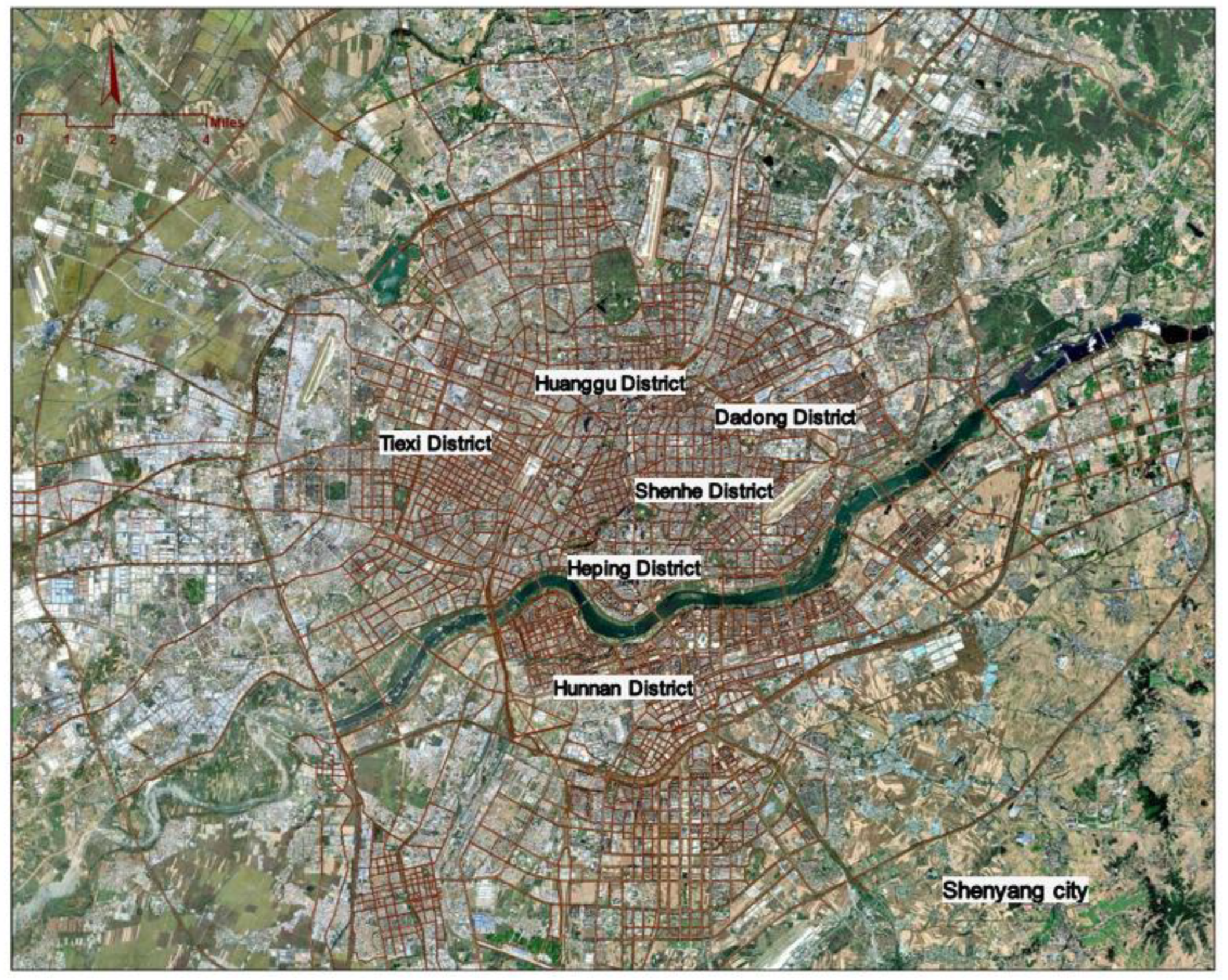
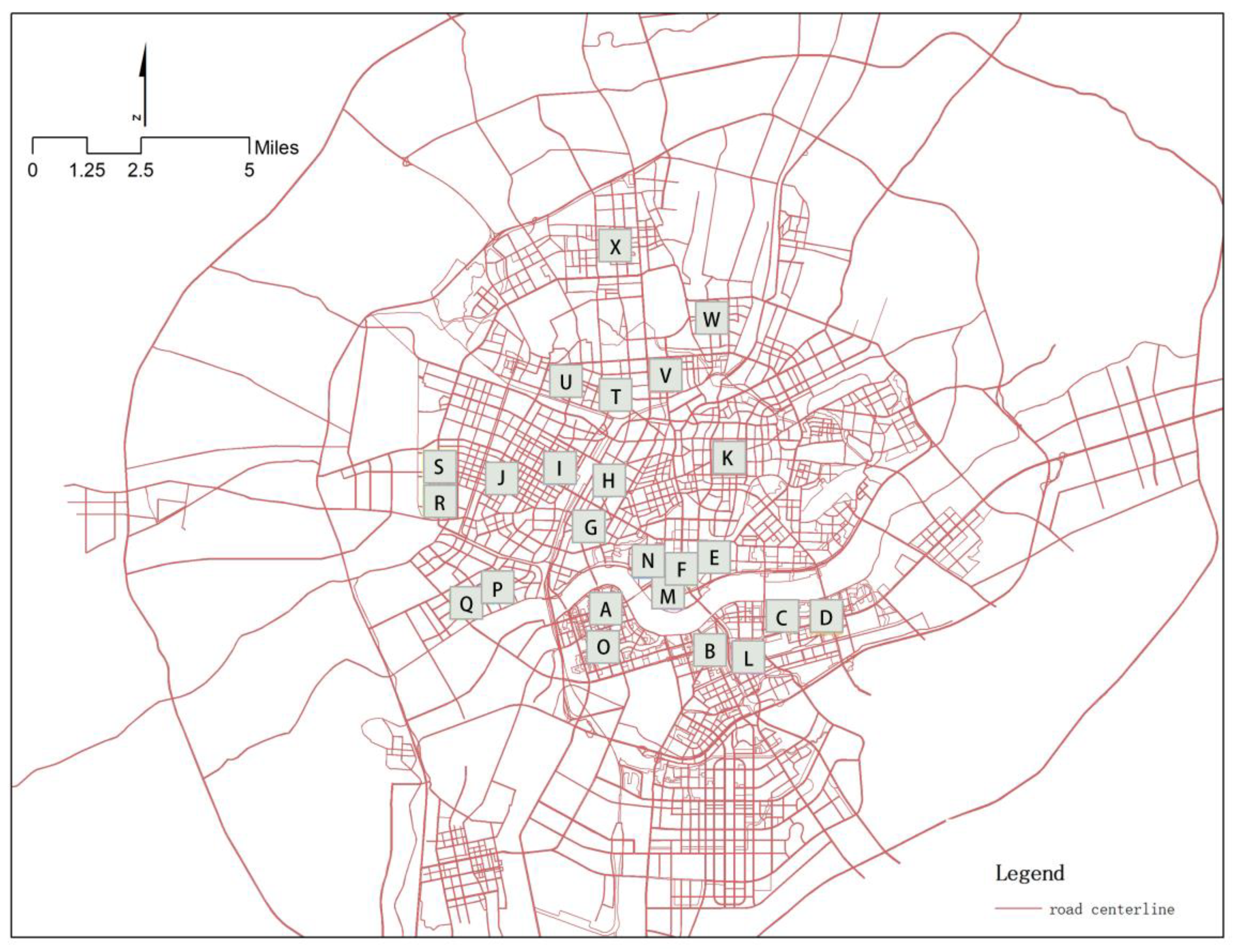

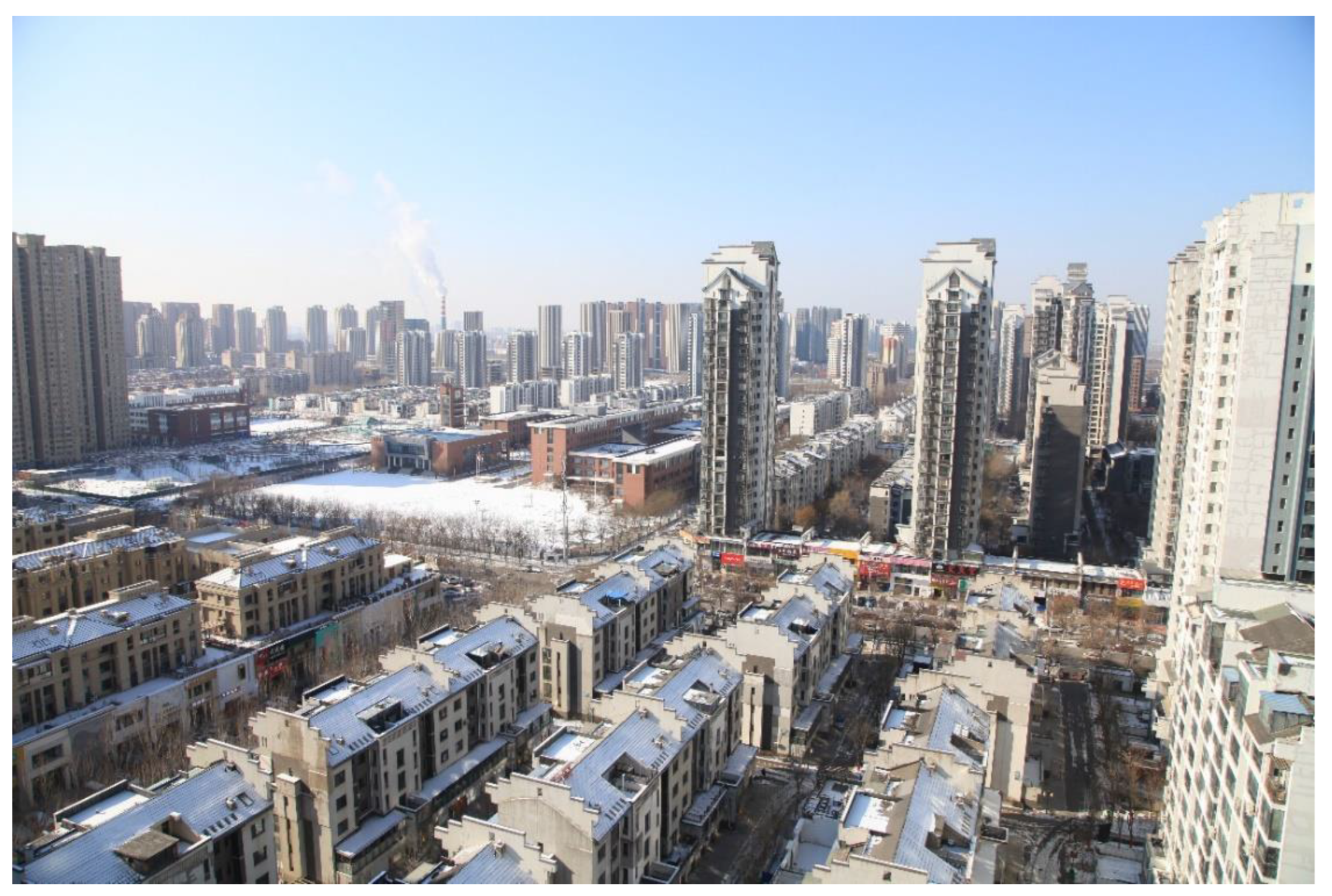
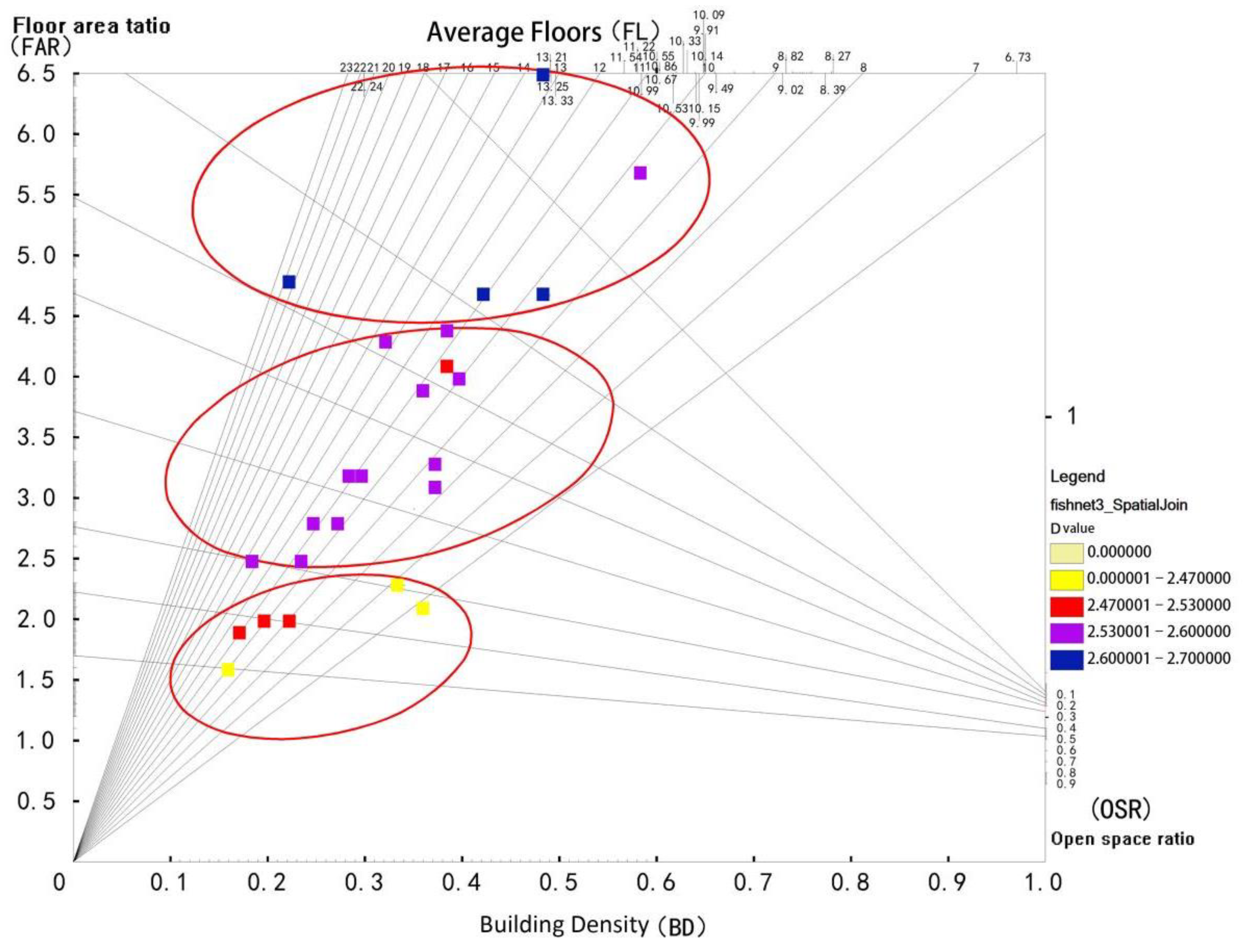
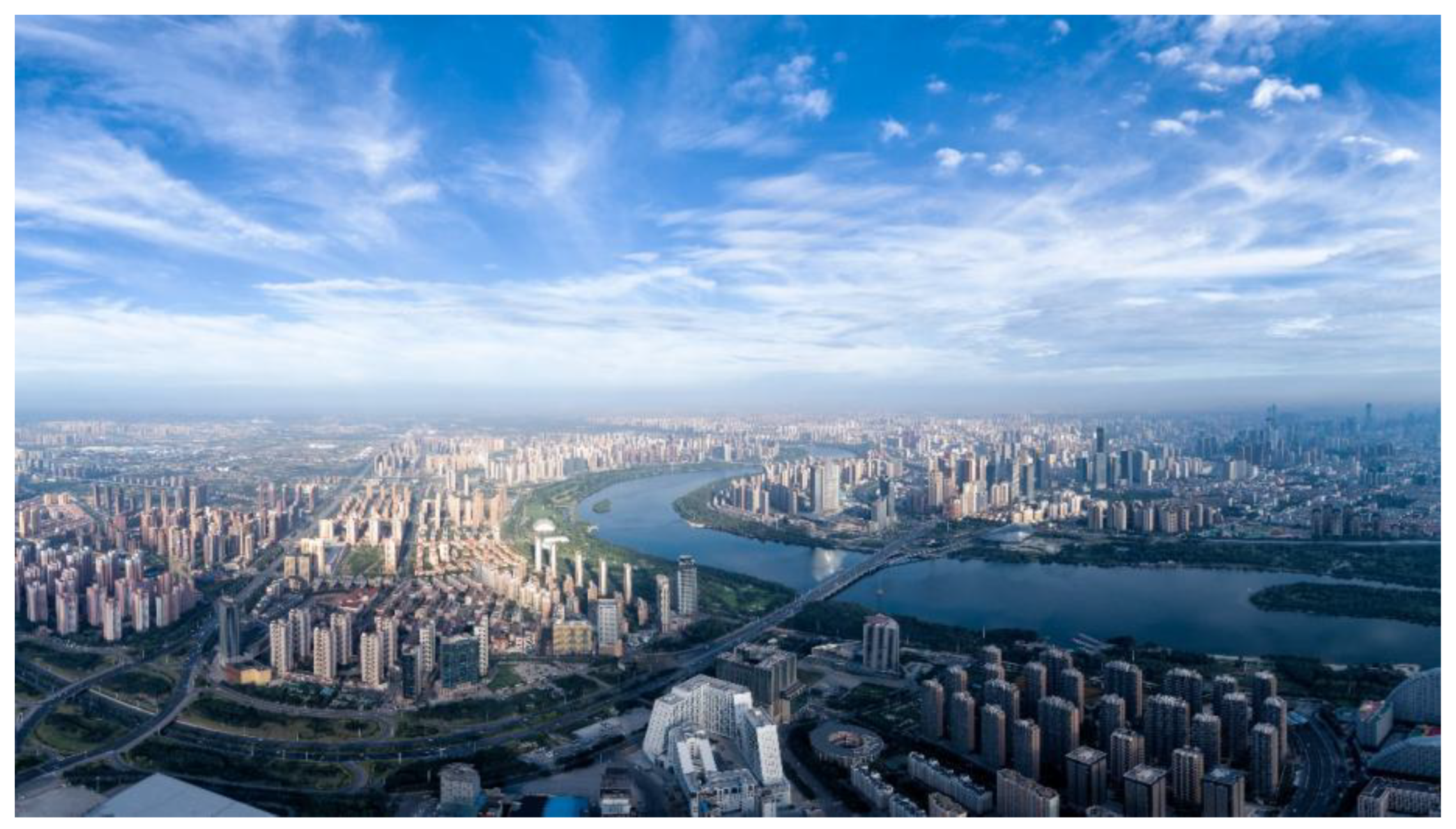
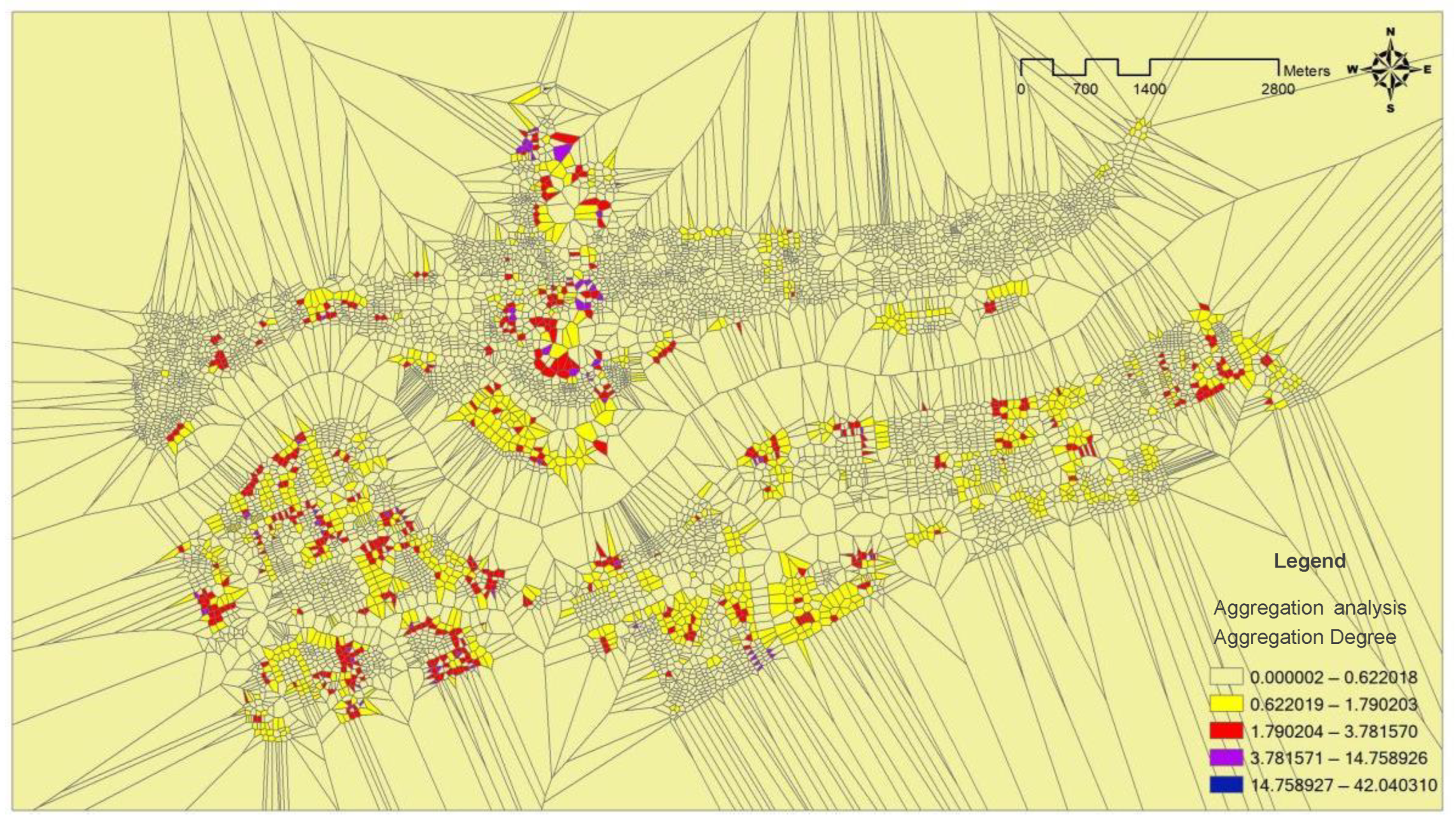
| A | B | C | D | E | F |
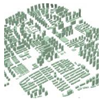 | 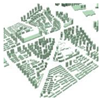 |  | 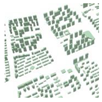 | 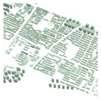 | 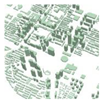 |
| G | H | I | J | K | L |
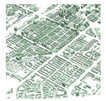 | 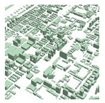 | 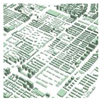 | 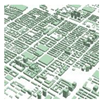 |  |  |
| M | N | O | P | Q | R |
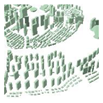 | 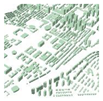 | 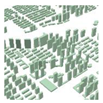 |  | 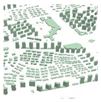 |  |
| S | T | U | V | W | X |
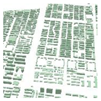 | 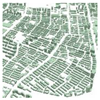 |  |  |  | 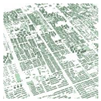 |
| Grid Size r (m) | 1200 | 600 | 300 | 150 | 75 | 37.5 | 18.75 |
|---|---|---|---|---|---|---|---|
| Box height | 300/21 | 300/22 | 300/23 | 300/24 | 300/25 | 300/26 | 300/27 |
| 150 | 75 | 37.5 | 18.75 | 9.375 | 4.688 | 2.344 |
| Grid Size r (m) | 1200 | 600 | 300 | 150 | 75 | 37.5 | 18.75 | |
|---|---|---|---|---|---|---|---|---|
| A | Non-empty boxes N | 1 | 4 | 16 | 63 | 237 | 776 | 2191 |
| B | Non-empty boxes N | 1 | 4 | 16 | 64 | 228 | 620 | 1851 |
| C | Non-empty boxes N | 1 | 4 | 16 | 58 | 201 | 676 | 1736 |
| D | Non-empty boxes N | 1 | 4 | 16 | 63 | 206 | 676 | 1620 |
| E | Non-empty boxes N | 1 | 4 | 16 | 64 | 239 | 848 | 2738 |
| F | Non-empty boxes N | 1 | 4 | 16 | 60 | 214 | 707 | 2118 |
| G | Non-empty boxes N | 1 | 4 | 16 | 64 | 250 | 972 | 3397 |
| H | Non-empty boxes N | 1 | 4 | 16 | 63 | 247 | 883 | 2890 |
| I | Non-empty boxes N | 1 | 4 | 16 | 64 | 256 | 971 | 3050 |
| J | Non-empty boxes N | 1 | 4 | 16 | 64 | 256 | 991 | 3470 |
| K | Non-empty boxes N | 1 | 4 | 16 | 64 | 249 | 957 | 3391 |
| L | Non-empty boxes N | 1 | 4 | 16 | 62 | 212 | 610 | 1600 |
| M | Non-empty boxes N | 1 | 4 | 15 | 56 | 188 | 562 | 1597 |
| N | Non-empty boxes N | 1 | 4 | 16 | 63 | 233 | 795 | 2346 |
| O | Non-empty boxes N | 1 | 4 | 16 | 59 | 203 | 666 | 1913 |
| P | Non-empty boxes N | 1 | 4 | 16 | 64 | 241 | 753 | 2027 |
| Q | Non-empty boxes N | 1 | 4 | 16 | 63 | 240 | 787 | 2199 |
| R | Non-empty boxes N | 1 | 4 | 16 | 64 | 252 | 944 | 2900 |
| S | Non-empty boxes N | 1 | 4 | 16 | 64 | 255 | 928 | 2982 |
| T | Non-empty boxes N | 1 | 4 | 16 | 64 | 256 | 996 | 3465 |
| U | Non-empty boxes N | 1 | 4 | 16 | 64 | 253 | 937 | 2855 |
| V | Non-empty boxes N | 1 | 4 | 16 | 64 | 240 | 846 | 2754 |
| W | Non-empty boxes N | 1 | 4 | 16 | 64 | 254 | 938 | 2824 |
| X | Non-empty boxes N | 1 | 4 | 16 | 64 | 252 | 945 | 2804 |
| Grid Size r (m) | 1200 | 600 | 300 | 150 | 75 | 37.5 | 18.75 | |
|---|---|---|---|---|---|---|---|---|
| Box Height (m) | 300/21 | 300/22 | 300/23 | 300/24 | 300/25 | 300/26 | 300/27 | |
| A | Non-empty boxes N | 1 | 4 | 23 | 162 | 1067 | 6481 | 33,048 |
| B | Non-empty boxes N | 1 | 4 | 16 | 113 | 1232 | 6822 | 30,851 |
| C | Non-empty boxes N | 1 | 4 | 17 | 76 | 736 | 4761 | 22,290 |
| D | Non-empty boxes N | 1 | 4 | 21 | 97 | 971 | 5252 | 25,113 |
| E | Non-empty boxes N | 1 | 4 | 21 | 69 | 566 | 3534 | 21,852 |
| F | Non-empty boxes N | 1 | 4 | 22 | 109 | 1157 | 6960 | 37,731 |
| G | Non-empty boxes N | 1 | 4 | 18 | 134 | 918 | 6872 | 21,060 |
| H | Non-empty boxes N | 1 | 4 | 23 | 162 | 1163 | 7968 | 51,312 |
| I | Non-empty boxes N | 1 | 4 | 18 | 127 | 902 | 6232 | 38,073 |
| J | Non-empty boxes N | 1 | 4 | 17 | 138 | 981 | 7222 | 49,455 |
| K | Non-empty boxes N | 1 | 4 | 16 | 118 | 774 | 5635 | 39,316 |
| L | Non-empty boxes N | 1 | 4 | 48 | 322 | 2027 | 11,325 | 54,575 |
| M | Non-empty boxes N | 1 | 5 | 15 | 187 | 1151 | 6363 | 31,342 |
| N | Non-empty boxes N | 1 | 4 | 16 | 92 | 645 | 4122 | 22,943 |
| O | Non-empty boxes N | 1 | 4 | 23 | 153 | 889 | 5278 | 26,794 |
| P | Non-empty boxes N | 1 | 4 | 22 | 133 | 977 | 5810 | 28,272 |
| Q | Non-empty boxes N | 1 | 4 | 24 | 165 | 1137 | 7284 | 36,176 |
| R | Non-empty boxes N | 1 | 4 | 16 | 122 | 800 | 5686 | 33,261 |
| S | Non-empty boxes N | 1 | 4 | 16 | 115 | 770 | 5283 | 32,322 |
| T | Non-empty boxes N | 1 | 4 | 17 | 136 | 961 | 7121 | 47,104 |
| U | Non-empty boxes N | 1 | 4 | 22 | 141 | 1014 | 6971 | 40,573 |
| V | Non-empty boxes N | 1 | 4 | 21 | 160 | 1064 | 6995 | 41,339 |
| W | Non-empty boxes N | 1 | 4 | 22 | 162 | 1154 | 8223 | 45,713 |
| X | Non-empty boxes N | 1 | 4 | 18 | 135 | 969 | 6918 | 36,849 |
| Indicators | A | B | C | D | E | F | G | H | I | J | K | L |
|---|---|---|---|---|---|---|---|---|---|---|---|---|
| Two-dimensional D values | 1.87 | 1.83 | 1.81 | 1.80 | 1.91 | 1.85 | 1.96 | 1.93 | 1.95 | 1.97 | 1.96 | 1.79 |
| Three-dimensional D values | 2.57 | 2.55 | 2.47 | 2.50 | 2.41 | 2.60 | 2.51 | 2.66 | 2.59 | 2.65 | 2.58 | 2.70 |
| Floor area ratio | 2.74 | 2.47 | 1.60 | 1.84 | 2.13 | 4.24 | 4.04 | 6.48 | 3.28 | 4.67 | 5.52 | 4.78 |
| Building density | 0.27 | 0.24 | 0.16 | 0.17 | 0.36 | 0.32 | 0.39 | 0.49 | 0.37 | 0.42 | 0.58 | 0.22 |
| Standard deviation of floors | 11.50 | 12.60 | 8.69 | 10.06 | 4.86 | 15.80 | 6.59 | 12.73 | 7.55 | 4.71 | 4.70 | 26.49 |
| Average floors | 10.15 | 10.14 | 9.91 | 10.55 | 5.87 | 13.21 | 10.33 | 13.25 | 8.82 | 10.99 | 9.49 | 22.24 |
| Indicators | M | N | O | P | Q | R | S | T | U | V | W | X |
| Two-dimensional D values | 1.78 | 1.88 | 1.83 | 1.86 | 1.87 | 1.94 | 1.94 | 1.97 | 1.93 | 1.92 | 1.93 | 1.93 |
| Three-dimensional D values | 2.56 | 2.46 | 2.50 | 2.53 | 2.59 | 2.56 | 2.55 | 2.59 | 2.58 | 2.58 | 2.60 | 2.58 |
| Floor area ratio | 2.49 | 2.28 | 2.02 | 1.96 | 2.80 | 2.91 | 3.11 | 4.01 | 3.16 | 4.36 | 3.88 | 3.14 |
| Building density | 0.19 | 0.34 | 0.20 | 0.22 | 0.25 | 0.35 | 0.37 | 0.40 | 0.30 | 0.38 | 0.36 | 0.29 |
| Standard deviation of floors | 14.87 | 7.49 | 10.68 | 11.23 | 11.02 | 4.46 | 4.34 | 6.96 | 10.23 | 11 | 14.34 | 6.57 |
| Average floors | 13.33 | 6.73 | 9.99 | 9.02 | 11.12 | 8.27 | 8.39 | 10.09 | 10.53 | 11.54 | 10.86 | 10.67 |
Publisher’s Note: MDPI stays neutral with regard to jurisdictional claims in published maps and institutional affiliations. |
© 2022 by the authors. Licensee MDPI, Basel, Switzerland. This article is an open access article distributed under the terms and conditions of the Creative Commons Attribution (CC BY) license (https://creativecommons.org/licenses/by/4.0/).
Share and Cite
Liu, S.; Chen, Y. A Three-Dimensional Box-Counting Method to Study the Fractal Characteristics of Urban Areas in Shenyang, Northeast China. Buildings 2022, 12, 299. https://doi.org/10.3390/buildings12030299
Liu S, Chen Y. A Three-Dimensional Box-Counting Method to Study the Fractal Characteristics of Urban Areas in Shenyang, Northeast China. Buildings. 2022; 12(3):299. https://doi.org/10.3390/buildings12030299
Chicago/Turabian StyleLiu, Shengjun, and Yijing Chen. 2022. "A Three-Dimensional Box-Counting Method to Study the Fractal Characteristics of Urban Areas in Shenyang, Northeast China" Buildings 12, no. 3: 299. https://doi.org/10.3390/buildings12030299
APA StyleLiu, S., & Chen, Y. (2022). A Three-Dimensional Box-Counting Method to Study the Fractal Characteristics of Urban Areas in Shenyang, Northeast China. Buildings, 12(3), 299. https://doi.org/10.3390/buildings12030299






